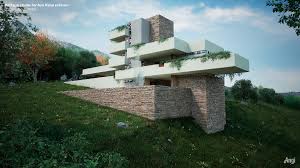Exploring the Timeless Beauty of Frank Lloyd Wright Houses

The Iconic Frank Lloyd Wright Houses
Frank Lloyd Wright, a pioneering American architect, is renowned for his innovative designs that harmonize with nature. His houses are celebrated for their organic architecture, open floor plans, and integration of indoor and outdoor spaces.
Wright’s architectural philosophy emphasized the use of natural materials, such as wood and stone, to create structures that blend seamlessly with their surroundings. His visionary approach to design revolutionized the concept of residential living in the early 20th century.
Fallingwater
One of Wright’s most famous creations is Fallingwater, located in Pennsylvania. Built in 1935, this masterpiece is built over a waterfall, seamlessly integrating nature into the design. The cantilevered terraces and expansive windows offer breathtaking views of the surrounding landscape.
Taliesin West
Taliesin West, situated in Arizona, served as Wright’s winter home and studio. Designed in 1937, this desert masterpiece showcases Wright’s use of local materials and his innovative approach to desert architecture. The building blends into the rugged terrain, embodying Wright’s belief in organic architecture.
Robie House
The Robie House in Chicago is a prime example of Wright’s Prairie School style. Completed in 1910, this iconic house features horizontal lines, overhanging eaves, and intricate geometric patterns that define the Prairie style. The open floor plan and emphasis on horizontal space create a sense of unity with the surrounding landscape.
Frank Lloyd Wright’s houses continue to inspire architects and enthusiasts around the world with their timeless beauty and innovative design concepts. Each structure reflects Wright’s vision of creating harmonious living spaces that connect people with nature.
Top 6 Frequently Asked Questions About Frank Lloyd Wright Houses
- What are some famous Frank Lloyd Wright houses?
- How many houses did Frank Lloyd Wright design?
- What is unique about Frank Lloyd Wright’s architectural style?
- Are Frank Lloyd Wright houses open to the public for tours?
- Where can I find a list of all Frank Lloyd Wright houses?
- What inspired Frank Lloyd Wright in his house designs?
What are some famous Frank Lloyd Wright houses?
Some of the most famous Frank Lloyd Wright houses include Fallingwater in Pennsylvania, renowned for its integration with a waterfall and surrounding nature; Taliesin West in Arizona, showcasing Wright’s innovative desert architecture and use of local materials; and the Robie House in Chicago, a prime example of his Prairie School style with horizontal lines and open floor plans. These iconic houses exemplify Wright’s visionary approach to design, emphasizing harmony with nature and creating spaces that inspire awe and admiration.
How many houses did Frank Lloyd Wright design?
Frank Lloyd Wright, a prolific architect known for his groundbreaking designs, created over 500 completed structures throughout his career. These include private residences, public buildings, and commercial projects that showcase his innovative architectural style and visionary approach to design. Wright’s diverse portfolio of houses reflects his commitment to creating harmonious living spaces that integrate with their natural surroundings while pushing the boundaries of conventional architecture. Each of his creations bears the signature touch of Frank Lloyd Wright’s unique vision and continues to captivate admirers worldwide with their timeless beauty and enduring relevance in the world of architecture.
What is unique about Frank Lloyd Wright’s architectural style?
Frank Lloyd Wright’s architectural style is characterized by its unique blend of nature and design, creating structures that seamlessly integrate with their surroundings. One of the key aspects that set Wright’s work apart is his emphasis on organic architecture, which seeks to harmonize buildings with the natural environment. His open floor plans, use of natural materials like wood and stone, and incorporation of expansive windows that bring the outdoors inside are hallmarks of his style. Additionally, Wright’s innovative approach to space and light, along with his attention to detail and craftsmanship, have made his houses iconic examples of modern architecture that continue to inspire architects and admirers worldwide.
Are Frank Lloyd Wright houses open to the public for tours?
Many Frank Lloyd Wright houses are open to the public for tours, offering visitors a unique opportunity to experience the visionary architect’s iconic designs firsthand. These tours provide insight into Wright’s innovative approach to architecture and showcase his mastery of blending nature with built environments. From Fallingwater in Pennsylvania to Taliesin West in Arizona, visitors can explore these architectural gems and appreciate the timeless beauty and significance of Wright’s residential masterpieces.Guided tours often offer a deeper understanding of the design principles and historical context behind each house, allowing visitors to immerse themselves in the legacy of one of America’s most influential architects.
Where can I find a list of all Frank Lloyd Wright houses?
If you are looking for a comprehensive list of all Frank Lloyd Wright houses, there are several resources available online that provide detailed information on his architectural works. Websites such as the Frank Lloyd Wright Foundation and the Frank Lloyd Wright Building Conservancy offer extensive databases and archives that catalog Wright’s projects, including his residential designs. Additionally, books, documentaries, and exhibitions dedicated to Frank Lloyd Wright often feature lists and descriptions of his notable houses, making it easier for enthusiasts and researchers to explore his prolific portfolio of architectural masterpieces.
What inspired Frank Lloyd Wright in his house designs?
Frank Lloyd Wright drew inspiration for his house designs from a variety of sources, including nature, Japanese architecture, and his own philosophy of organic architecture. Wright believed in creating structures that harmonized with their natural surroundings, incorporating elements such as open floor plans, expansive windows to bring the outdoors in, and the use of natural materials like wood and stone. His visits to Japan greatly influenced his design aesthetic, leading him to embrace simplicity, asymmetry, and a connection to the natural world in his architectural creations. Additionally, Wright’s belief in designing spaces that promote well-being and reflect the individuality of their inhabitants guided his innovative approach to residential design.
